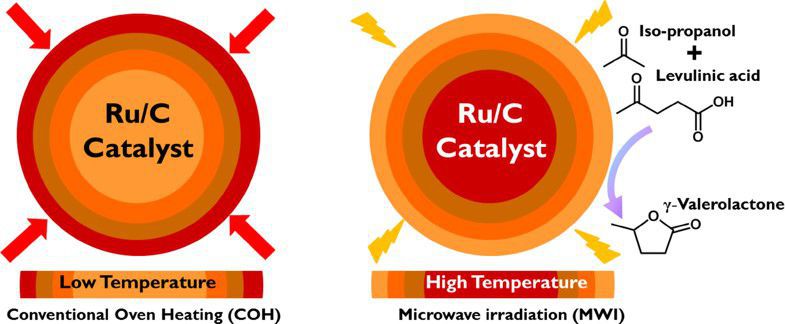| 論文篇名 | 英文:Microwave Irradiation-enhanced catalytic transfer hydrogenation of levulinic acid to γ-valerolactone using ruthenium: a comparative study with conventional heating processes 中文:釕對微波輻射增強乙酰丙酸催化轉移加氫成γ-戊內酯的作用:與常規加熱工藝的比較研究 |
| 期刊名稱 | Waste and Biomass Valorization |
| 發表年份,卷數,起迄頁數 | 2019, 1-11 |
| 作者 | WC Yun, TY Lin, HY Chiu, KYA Lin |
| DOI | 10.1007/s12649-019-00623-y |
| 中文摘要 | 使用常規烤箱加熱(COH)通過催化轉移氫化(CTH)將生物質衍生的乙酰丙酸轉化為γ-戊內酯(GVL)會帶來諸如反應時間長和產率低的問題。微波輻射(MWI)似乎是解決這些問題的解決方案,因為MWI可以縮短反應時間並提高產量。為了探索MWI對LA轉化的有效性,比較了MWI和COH通過模型催化劑Ru / C催化的CTH對LA轉化的影響。通過研究溫度和反應時間的影響,MWI與COH相比可縮短反應時間並提高LA轉化效率。使用MWI通過Ru / C將LA完全轉化為GVL的最佳條件是在160°C下30分鐘使用10 mg(Ru / C)/ mL(2-PrOH)。還證實了MWI可改善幾種常見的乙酰丙酸酯(LAE)向GVL的轉化。再生的Ru / C還可以表現出與使用MWI進行LA轉化的原始Ru / C幾乎相同的催化活性。這些結果表明Ru / C是用於LA轉化的高效催化劑,並且MWI可以通過縮短反應時間和增加GVL的產率進一步通過Ru / C提高LA轉化。因此,MWI是增強生物量轉化的有前途的過程。 |
| 英文摘要 | Conversion of biomass-derived levulinic acid to γ-valerolactone (GVL) via catalytic transfer hydrogenation (CTH) using conventional oven heating (COH) is associated with issues, such as long reaction time, and low yield. Microwave irradiation (MWI) appears to be a solution to address these issues as MWI can shorten reaction times and enhance yields. To explore effectiveness of MWI for LA conversion, MWI and COH are compared for LA conversion via CTH catalyzed by a model catalyst, Ru/C. Through investigating the effects of temperature and reaction time, MWI is validated to shorten the reaction time and enhance LA conversion efficiencies in comparison with COH. The optimal condition for the full LA conversion to GVL by Ru/C using MWI is 160 °C for 30 min with 10 mg (Ru/C)/mL (2-PrOH). MWI is also validated to improve conversion of several common levulinate esters (LAEs) to GVL. The regenerated Ru/C can also exhibit almost the same catalytic activity as the pristine Ru/C for LA conversion using MWI. These results indicate that Ru/C is a highly-effective catalyst for LA conversion and MWI can further enhance LA conversion by Ru/C by shortening reaction time and increasing yield of GVL. Thus, MWI is a promising process for enhancing biomass conversion. |
Microwave Irradiation-enhanced catalytic transfer hydrogenation of levulinic acid to γ-valerolactone using ruthenium: a comparative study with conventional heating processes 2019-02-25

循環農業:農業廢棄物高價值化【環工系林坤儀教授】






